|
Points: 158953 Followers
flyflyflyAdd flyflyfly as a friendflyflyfly will be notified and will have to accept this friendship request, to view updates from flyflyfly and their ratings you must follow them. |
Lists
|
|
Recent reviews
All reviews -
Movies (55)
Fantasia review
 Posted : 2 years, 3 months ago on 24 March 2023 11:22
(A review of Fantasia)
Posted : 2 years, 3 months ago on 24 March 2023 11:22
(A review of Fantasia)"The Sorcerer's Apprentice" and "Night on Bald Mountain", minus the didactic intros and weaker surrounding sequences, could be viewed on a standalone basis, after all, they are the most iconic vignettes in Walt Disney's least accessible feat. However, being deeply averse to the truncation, revision or dumbing down of the several hundred classic movies of yesteryear, cineastes refuse to "cheat" their way through their cinematic journey, to them even the most languidly paced, stuffy and dated pictures are worth the effort. No matter how it is viewed, piecemeal or in its entirety, "Fantasia" is rewarding and edifying, showcasing some truly astounding, vivid animated sequences bolstered by defined themes and surreal imagery that do actually benefit from the addition of classical music. Recommended, but don't expect to hugely entertained. 6.5, based mainly on my impression of the aforementioned segments.
 0 comments, Reply to this entry
0 comments, Reply to this entry
Re-Animator (1985) review
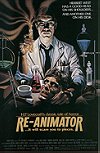 Posted : 4 years, 12 months ago on 6 July 2020 12:37
(A review of Re-Animator (1985))
Posted : 4 years, 12 months ago on 6 July 2020 12:37
(A review of Re-Animator (1985))Stuart Gordon’s enduring splatter classic riffs on many genres and defies logic, symbolic of most independent features from the '80s horror explosion, but supercharged by exceedingly well-written dialogue, "Re-Animator" ameliorates far above its counterparts. Based on H.P. Lovecraft’s classic terror tale ‘Herbert West – Reanimator’ and featuring dry, deadpan jokes aplenty, this zombie-laden, sexually graphic, insanely effective gorefest more than compensates for a lack of scientific exposition and plausibility in the plot, which centres on three students, one of whom advertises for a roommate and finds one in the form of Dr. Herbert West, the deliciously deranged mad scientist of the title. West's bizarre theories of reanimation are soon realised with the reluctant assistance of his overzealous roommate, and gruesome chaos naturally ensues. Low-budget though not perceptibly so, "Re-Animator" illustrates how, if well-executed, a B-movie concept and accomplished special effects can elevate even the weakest of scripts. Fortunately, "Re-Animator" is one of the strongest screen adaptations of an H.P. Lovecraft story, if not the freshest, modern revision of the well-worn Prometheus legend, albeit with grislier results.
Campy fun devoid of seriousness or sophistication and emphasised comedy and wit can push aside the most blatant flaw in a film, and by balancing over-the-top lunacy and excessive gore with a schlocky take on the Frankenstein theme, Gordon manages to achieve that. Eschewing the bounds of the classic Universal era as well as the mould of horror cliches, the film highlights the gore and amorality of medical science, as evidenced by West's experiments. Owing to its expedient pace, suitably hysterical performances, comical edginess and gross-out horror, "Re-Animator" rises above its cult movie trappings and is definitely one of the more virtuoso, strikingly explicit horrors of the 1980s.
Campy fun devoid of seriousness or sophistication and emphasised comedy and wit can push aside the most blatant flaw in a film, and by balancing over-the-top lunacy and excessive gore with a schlocky take on the Frankenstein theme, Gordon manages to achieve that. Eschewing the bounds of the classic Universal era as well as the mould of horror cliches, the film highlights the gore and amorality of medical science, as evidenced by West's experiments. Owing to its expedient pace, suitably hysterical performances, comical edginess and gross-out horror, "Re-Animator" rises above its cult movie trappings and is definitely one of the more virtuoso, strikingly explicit horrors of the 1980s.
 0 comments, Reply to this entry
0 comments, Reply to this entry
Day of the Dead review
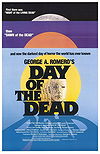 Posted : 4 years, 12 months ago on 6 July 2020 06:46
(A review of Day of the Dead)
Posted : 4 years, 12 months ago on 6 July 2020 06:46
(A review of Day of the Dead)Concluding the "Dead" franchise that began decades earlier, George A. Romero's "Day of the Dead" is a marginal improvement on many of the less developed areas of the prior entries. A number of intriguing building blocks are connected with residuum, as if the characters in "Dawn of the Dead" exist within the same universe as that of the previous sequel. Visually, a footprint is discernible, yet the main group of characters, and their motives and predicament differ greatly from the preceding films, although the premise remains: a zombie apocalypse has extremely decimated the human population, with the few remaining survivors forced to live in barricaded "security" in camps or underground. In one such facility, soldiers protect scientists attempting to find a solution to the pandemic. Previously, the zombies instinctively returned to their dull consumerist lifestyles by attacking a trio of survivors hiding out in a shopping mall; once in the presence of said humans, all succumbed to their innermost natures. In the present, the zombies are encircling an underground missile silo, with the soldiers and scientists offering different perspectives on exactly how to reverse the end of the world; simmering tensions and increasing animosity generate many tonal variances within the film, constituting the connective tissue of a plot structure. Each film has an explicit imprint, thematically and in terms of pervasive mood - in contrast to the claustrophobic horror onslaught of the first, a decidedly humorous, slapstick feel is evident in the second film. "Day of the Dead" is arguably the bleakest entry in the trilogy, examining the wider repercussions of the outbreak as well as the subtle interrelationships amid two opposed parties. As the character study yields to horror conventions once the soldiers learn that one such mad scientist is rehabilitating an imprisoned zombie through positive reinforcement and reward: the flesh of dead soldiers. All hell breaks loose as supplies dwindle, uncertainty abounds and initial veiled dismay and objection devolves into barely concealed verbal conflict and affray. Upon being unable to prove results in their mission and no additional survivors to be had, progress stalls and leadership struggles take hold, further damaging the morale. Romero observes the psychological dynamics of the group as if it were a social experiment as riveting and enthralling as the special effect-laden scenes incorporating the marauding zombies.
"Dawn of the Dead" revised and expanded upon the first film's race relations angle without referring to it implicitly, whereas "Day of the Dead" acknowledges the role of societal collapse in humanity's retrogression, proffering the root causes of the pandemic, namely, agitation, dissimulation, delusion, misinformation, opportunism, and a general lack of discourse. Survival and social unrest are entrenched in capitalism, the defining characteristic of the 1980s political landscape. Capitalism promotes self-preservation, maximisation, apathy and intransigence, and one could view the escalation of the situation within the bunker as a microcosm of Cold War tensions; as communication breaks down, the collective response to the situation descends into chaos as a scientist and her male cohorts clash with the increasingly toxic, dictatorial military personnel at the base. It is this intense pressure cooker environment that precipitates the film's tautly executed, strained sections of interplay, allowing for a much more satisfying pay-off as the group's cumulative animosity aggrandises to the point of no return. Romero constructs a logical edifice from the updated premise of each film in the trilogy, incorporating social commentary, i.e. rising hostilities and eroded societal systems, within a horror context. In studying two sequestered factions as they respond to the aftermath of a global emergency, dissension arises and tribalism becomes apparent in the strained interactions, highlighting volatility, paranoia and desperation as being incompatible with decision-making and diplomacy necessary to combat the disintegration of society and civilisation, with even the slightest incident capable of throwing us off course. Romero's conceit suggests that humanity's selfish myopia caused its own downfall, thus preventing them from averting further global catastrophe, which is in this case what happens after zombies have outnumbered humans - how do the survivors deal with the problem at hand? As expected, they panic, feud and refuse to compromise until complacency and in-fighting causes slip-ups; essentially, they slowly self-destruct.
I subscribe to Romero's pessimistic foretelling of the dissolution of society in all three films, but his most scathing attack on the military's magical thinking and belligerence incontrovertibly supports the fact that open discussion, transparency, amicability and neutral debate are imperative to avoid a combustible social situation unconducive to rectification. Scientific investigation and martial law fail to provide any resolution, and Romero's film ends on a dour note, but that is not to say the film is entirely depressing and despondent. In actuality, the film's prevailing mood is admittedly sombre, yet the dialogue-heavy sequences, littered with pithy put-downs and blackly comic touches courtesy of the soldiers and their zombie corral, as well as the mad scientist's grisly surgical and socialisation experiments, are funny and frank, derived from the first sequel's darkly humorous streak. Several of the most gruesome scenes vacillate between horror and comedy, though not at the expense of salience in terms of the plot or its sociopolitical slant, and therein lies Romero's genius. "Day of the Dead" stands in contrast to its predecessors in many respects, from the deeply haunting score, palpably claustrophobic sets, appreciable character development, to the overriding portent and unremitting menace present from the outset. Far less traditionally constructed, "Day of the Dead" therefore compensates for the second film's commercial leanings and characterisation shortcomings, resulting in a suspenseful, gratifying study of the human condition, with Romero's emblematic sociological substance tempering the ample gore and drollery. A satisfactory, fitting and ultimately hopeful closure to the trilogy that may be the least action-packed and ambitious but is definitely the eeriest and most philosophical zombie apocalypse movie of all-time.
"Dawn of the Dead" revised and expanded upon the first film's race relations angle without referring to it implicitly, whereas "Day of the Dead" acknowledges the role of societal collapse in humanity's retrogression, proffering the root causes of the pandemic, namely, agitation, dissimulation, delusion, misinformation, opportunism, and a general lack of discourse. Survival and social unrest are entrenched in capitalism, the defining characteristic of the 1980s political landscape. Capitalism promotes self-preservation, maximisation, apathy and intransigence, and one could view the escalation of the situation within the bunker as a microcosm of Cold War tensions; as communication breaks down, the collective response to the situation descends into chaos as a scientist and her male cohorts clash with the increasingly toxic, dictatorial military personnel at the base. It is this intense pressure cooker environment that precipitates the film's tautly executed, strained sections of interplay, allowing for a much more satisfying pay-off as the group's cumulative animosity aggrandises to the point of no return. Romero constructs a logical edifice from the updated premise of each film in the trilogy, incorporating social commentary, i.e. rising hostilities and eroded societal systems, within a horror context. In studying two sequestered factions as they respond to the aftermath of a global emergency, dissension arises and tribalism becomes apparent in the strained interactions, highlighting volatility, paranoia and desperation as being incompatible with decision-making and diplomacy necessary to combat the disintegration of society and civilisation, with even the slightest incident capable of throwing us off course. Romero's conceit suggests that humanity's selfish myopia caused its own downfall, thus preventing them from averting further global catastrophe, which is in this case what happens after zombies have outnumbered humans - how do the survivors deal with the problem at hand? As expected, they panic, feud and refuse to compromise until complacency and in-fighting causes slip-ups; essentially, they slowly self-destruct.
I subscribe to Romero's pessimistic foretelling of the dissolution of society in all three films, but his most scathing attack on the military's magical thinking and belligerence incontrovertibly supports the fact that open discussion, transparency, amicability and neutral debate are imperative to avoid a combustible social situation unconducive to rectification. Scientific investigation and martial law fail to provide any resolution, and Romero's film ends on a dour note, but that is not to say the film is entirely depressing and despondent. In actuality, the film's prevailing mood is admittedly sombre, yet the dialogue-heavy sequences, littered with pithy put-downs and blackly comic touches courtesy of the soldiers and their zombie corral, as well as the mad scientist's grisly surgical and socialisation experiments, are funny and frank, derived from the first sequel's darkly humorous streak. Several of the most gruesome scenes vacillate between horror and comedy, though not at the expense of salience in terms of the plot or its sociopolitical slant, and therein lies Romero's genius. "Day of the Dead" stands in contrast to its predecessors in many respects, from the deeply haunting score, palpably claustrophobic sets, appreciable character development, to the overriding portent and unremitting menace present from the outset. Far less traditionally constructed, "Day of the Dead" therefore compensates for the second film's commercial leanings and characterisation shortcomings, resulting in a suspenseful, gratifying study of the human condition, with Romero's emblematic sociological substance tempering the ample gore and drollery. A satisfactory, fitting and ultimately hopeful closure to the trilogy that may be the least action-packed and ambitious but is definitely the eeriest and most philosophical zombie apocalypse movie of all-time.
 0 comments, Reply to this entry
0 comments, Reply to this entry
The Quiet Man (1952) review
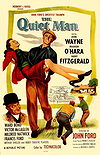 Posted : 4 years, 12 months ago on 2 July 2020 05:27
(A review of The Quiet Man (1952))
Posted : 4 years, 12 months ago on 2 July 2020 05:27
(A review of The Quiet Man (1952))Nostalgia abounds John Ford's glitteringly perfect adaptation of a Maurice Walsh story he acquired the rights for in 1946. "The Quiet Man" is Ford's broadly comic, inherently charming foray into blarney that never once mocks or feels bogus, even if the setting of Inisfree was entirely fictional. In fact, Ford persisted with the studio, even accepting a meagre budget, if they allowed him to shoot in Ireland, much of which is capitalised on during the climactic punch-up between John Wayne and Victor McLaglen. Inisfree's scenic backgrounds are stunningly realised by Technicolor photography courtesy of Winton Hoch, whose vivid compositions capture the panoramic beauty of the Irish countryside, earning him a much-deserved Oscar. Mixing genre forms such as action, comedy and romance was not new ground for John Ford, but his leading lady Maureen O’Hara, whose steely-eyed sensual magnetism as the feisty, high-spirited Mary Kate Danaher contrasts with her usually timid female ciphers, enabled him to surmount the melodrama and sentimentality his non-Westerns were predisposed to. John Wayne and Maureen O'Hara's incredible chemistry skyrockets the romantic leanings of the film, entering their rain-soaked kissing scene into the annals of cinema history.
John Ford's no-frame-wasted approach undoubtedly secured his position as one of cinema's most respected directors, and his post-war output remains popular with audiences, particularly "The Quiet Man" and "The Searchers". Admired by audiences and critics alike, "The Quiet Man" is so accessible it is now considered Sunday afternoon fare when in fact it is so much more than that. Unequivocally endearing though it is, the lush cinematography and prevailing exuberance augment the amusing romanticism and ribald rhapsody; the softening of Ford's unsophisticated features has broadened their enthral for older generations. Why is it so objectionable for a well-crafted, congenial slice of pure entertainment loaded with universal back-slapping humour and unbridled appeal to be considered a masterpiece? Quite simply, because Ford's aim was not to create a masterpiece. "The Quiet Man" is neither maudlin or pompous, psychologically or morally complex - it is sublimely simplistic, lacking the lyricism of his deeper westerns, and is more enjoyable as a result. Ford's biggest cinematic departure saw him utilise a fine cast, authentic dialogue and breathtaking backdrop to present Irish life as it was in the 1920s, albeit from the fish-out-of-water perspective of an American boxer seeking to reconnect with his roots only to fall in love with a bullying landowner's fiery sister. A joy to behold on every level, films as beautifully shot and executed as this on location in Ireland are non-existent. Moreover, there are no films concerning Irish society devoid of religious and political animosity. "The Quiet Man" depicts a crowd-pleasing and anachronistic, idealistic version of Ireland ruled by anachronistic customs, community standing, respectability, dowries and drunken donnybrooks. According to O'Hara, John Ford longed to be an Irish rebel - this effusive, disarming film adds credence to that statement.
John Ford's no-frame-wasted approach undoubtedly secured his position as one of cinema's most respected directors, and his post-war output remains popular with audiences, particularly "The Quiet Man" and "The Searchers". Admired by audiences and critics alike, "The Quiet Man" is so accessible it is now considered Sunday afternoon fare when in fact it is so much more than that. Unequivocally endearing though it is, the lush cinematography and prevailing exuberance augment the amusing romanticism and ribald rhapsody; the softening of Ford's unsophisticated features has broadened their enthral for older generations. Why is it so objectionable for a well-crafted, congenial slice of pure entertainment loaded with universal back-slapping humour and unbridled appeal to be considered a masterpiece? Quite simply, because Ford's aim was not to create a masterpiece. "The Quiet Man" is neither maudlin or pompous, psychologically or morally complex - it is sublimely simplistic, lacking the lyricism of his deeper westerns, and is more enjoyable as a result. Ford's biggest cinematic departure saw him utilise a fine cast, authentic dialogue and breathtaking backdrop to present Irish life as it was in the 1920s, albeit from the fish-out-of-water perspective of an American boxer seeking to reconnect with his roots only to fall in love with a bullying landowner's fiery sister. A joy to behold on every level, films as beautifully shot and executed as this on location in Ireland are non-existent. Moreover, there are no films concerning Irish society devoid of religious and political animosity. "The Quiet Man" depicts a crowd-pleasing and anachronistic, idealistic version of Ireland ruled by anachronistic customs, community standing, respectability, dowries and drunken donnybrooks. According to O'Hara, John Ford longed to be an Irish rebel - this effusive, disarming film adds credence to that statement.
 0 comments, Reply to this entry
0 comments, Reply to this entry
Suspiria (1977) review
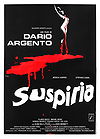 Posted : 5 years ago on 1 July 2020 10:35
(A review of Suspiria (1977))
Posted : 5 years ago on 1 July 2020 10:35
(A review of Suspiria (1977))Noteworthy for its detached, delusory setting and characterised by express shifts in light and colour, "Suspiria" accurately captures the visceral perception and sensation of a nightmare, which in this context centres on witchcraft. In part inspired by the vivid hand-drawn cut-out animation of "Snow White and the Seven Dwarfs", the film was shot with evocative Eastman colour stock and Technicolor processing to achieve a palpable, entirely unique neon composition. Utilising complex lighting methods, peculiar camera angles, and meticulously designed set-pieces, the majority of "Suspiria" does have the striking effect of an animation in that its chromatic delineation, shot using anamorphic lenses, is a sense-driven, diverting experience that is as much illustrative and stylised as it is psychologically dynamic. Each frame is intricately composed with staggering attention to detail, emphasising a retina-scarring primary colour scheme and facile narrative drive; imbuing the elaborate, harrowing murder sequences with a feverish surrealism, the clear aim is to channel the baroque, bizarre aspects of a fairy-tale. Argento's technical proficiency is integral to the film's opulence and potency, and despite the minimalist plot and wooden performances, the illusive mood and vibrancy of the aesthetic compensates for any observable deficiencies, not that there are any glaring detrimental factors. In all respects, the film's perceptible faults are present in most Italian horror films of the time and are synonymous with the subgenre, perhaps even part of its charm and appeal.
Dario Argento's impenitently superficial masterpiece is at once ambient and phantasmal, glossy and ghastly, hysterical and hazy. Eurohorror reached lofty heights with Argento's excessively stylistic flourishes, derisory storylines deftly structured to anchor the pronounced tableaux, stilted dialogue, and fear-inducing musical scores. "Suspiria" inflates the creative potential of so-called low art of B-movie genre forms by weaving a series of inexplicable, grisly events around the luridly beautiful dreamscape we succumb to most willingly. In a film in which the protagonist's intrigued consciousness intrepidly guides us into a hallucinatory microcosm ripe with suggestion and subtext before capitalising on its over-arching theme of the occult with laser-like focus, extrapolating it into a beguiling showcase of sound and vision that proves more involving than a densely plotted narrative structure. As it is, the story concerns an American dancer who joins a prestigious ballet school in Berlin only to uncover that it is in fact operated by a coven of murderous witches. It is upon this premise that a darkness is built and tension compounded; Argento deepens the tenebrosity and amplifies the blood-soaked terror through the electric colour palette, leaving a mental imprint until it becomes cognisant. Expressing as much blistering artistry as one can out of gore and attributes of psychedelia and mystery, Argento's pulpy supernatural conspiracy is a rich exposition of giallo, albeit with a Gothic slant, delivering an immersive exegesis so powerful that it engulfs the viewer's field of vision, flooding it with detailed symbolism and haunting music courtesy of Goblin. It is this synergy between cinematography, direction and set design that, on the basis of graphic, kaleidoscopic luminosity, creates expressive images with a sheen and sophistication rarely seen in horror cinema, thus expanding the possibilities of the genre. Owing to this fastidious precision and cinematic impulse, "Suspiria" still holds up to scrutiny even after almost half a century, and the end result is no less mesmerising and satisfying. From the rain-soaked, hazy opening scene to the macabre climax, this is cerebral horror cinema at its finest.
Dario Argento's impenitently superficial masterpiece is at once ambient and phantasmal, glossy and ghastly, hysterical and hazy. Eurohorror reached lofty heights with Argento's excessively stylistic flourishes, derisory storylines deftly structured to anchor the pronounced tableaux, stilted dialogue, and fear-inducing musical scores. "Suspiria" inflates the creative potential of so-called low art of B-movie genre forms by weaving a series of inexplicable, grisly events around the luridly beautiful dreamscape we succumb to most willingly. In a film in which the protagonist's intrigued consciousness intrepidly guides us into a hallucinatory microcosm ripe with suggestion and subtext before capitalising on its over-arching theme of the occult with laser-like focus, extrapolating it into a beguiling showcase of sound and vision that proves more involving than a densely plotted narrative structure. As it is, the story concerns an American dancer who joins a prestigious ballet school in Berlin only to uncover that it is in fact operated by a coven of murderous witches. It is upon this premise that a darkness is built and tension compounded; Argento deepens the tenebrosity and amplifies the blood-soaked terror through the electric colour palette, leaving a mental imprint until it becomes cognisant. Expressing as much blistering artistry as one can out of gore and attributes of psychedelia and mystery, Argento's pulpy supernatural conspiracy is a rich exposition of giallo, albeit with a Gothic slant, delivering an immersive exegesis so powerful that it engulfs the viewer's field of vision, flooding it with detailed symbolism and haunting music courtesy of Goblin. It is this synergy between cinematography, direction and set design that, on the basis of graphic, kaleidoscopic luminosity, creates expressive images with a sheen and sophistication rarely seen in horror cinema, thus expanding the possibilities of the genre. Owing to this fastidious precision and cinematic impulse, "Suspiria" still holds up to scrutiny even after almost half a century, and the end result is no less mesmerising and satisfying. From the rain-soaked, hazy opening scene to the macabre climax, this is cerebral horror cinema at its finest.
 0 comments, Reply to this entry
0 comments, Reply to this entry
Blood and Black Lace (1976) review
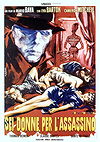 Posted : 5 years ago on 1 July 2020 05:43
(A review of Blood and Black Lace (1976))
Posted : 5 years ago on 1 July 2020 05:43
(A review of Blood and Black Lace (1976))Creating a pervasive, pernicious atmosphere within a film should be akin to experiencing a lucid dream that upon recollection, remains visually familiar, but more or less inscrutable. Such an experience is not extremely rare in cinema, but it is largely uncommon. If one returns to the aforementioned dream-like model of film, that initial and subsequent experience is repeated, the plot and outcome becomes secondary, it is the potency of the context that triggers immediate recognition. Even if the narrative and story elements are recognisable, it is the contiguous atmosphere that retains its mesmeric qualities when viewed as a standalone work employing an unsettling ethereal tone. Mario Bava was one of few directors able to attain this intensely meditative, superficial firmament that was easy to return to if one was in the right mindset to do so. "Blood and Black Lace" is Mario Bava's masterpiece, his only directorial effort with enough merit to warrant the term. Despite a long and varied career akin to Dario Argento, Bava's early, hallucinatory work was considered a postmark, modifying the thriller template with pulpy excess, visible nudity and gore, not to mention the now-iconic visual motifs synonymous with the genre. He did not achieve the wider popularity afford to his contemporaries, but "Blood and Black Lace" effectively placed Bava on the map outside of Italy and is more than worthy of extolling. With its highly effective use of colour and lighting to achieve its entrancing illusionary look and ambience, this deeply hyper-visual early giallo exemplifies the genre whilst establishing its own set of codes and stylistic touches. The story is merely a framing device, concerning the search for desperate serial killer in a stocking mask whose victims are the young models of a fashion house in Rome. Commenting perhaps on the commodification and redundancy of models, the script is serviceable, characters two-dimensional and the performances typically wooden, yet all of that is perfectly apt since the emphasis herein is on style, not substance. One must abandon the urge to scrutinise its cinematic weaknesses and focus on the polychromatic flamboyancy of the proceedings and the choreographed, brilliantly staged murders - therein lies the film's high artistry. Garish and prismatic, the film revels in its "moving painting" cinematography, using thick shadows as much as dazzling colours to enhance the prevailing trance-like mood cast by Bava, his camera glissading through a blood-splattered dance of death, entirely responsive and alert to the disconcertingly clinical and glamorous surroundings.
Overlook the film's shortcomings and you will be rewarded with a suspenseful spectacle like no other; the lurid, outmoded aspects integral to its allure, its framed morbid beauty a stunning collision of high and low art, "Blood and Black Lace" is essential viewing for any horror fan, but also as one of the most paradoxically beautiful and preternaturally eerie films of all-time.
Overlook the film's shortcomings and you will be rewarded with a suspenseful spectacle like no other; the lurid, outmoded aspects integral to its allure, its framed morbid beauty a stunning collision of high and low art, "Blood and Black Lace" is essential viewing for any horror fan, but also as one of the most paradoxically beautiful and preternaturally eerie films of all-time.
 0 comments, Reply to this entry
0 comments, Reply to this entry
The Rocky Horror Picture Show review
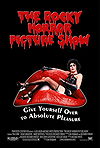 Posted : 5 years ago on 28 June 2020 01:55
(A review of The Rocky Horror Picture Show)
Posted : 5 years ago on 28 June 2020 01:55
(A review of The Rocky Horror Picture Show)An uproarious, enthralling and erratic low-brow performance art amalgamation of vividly-coloured punk and kitsch, "The Rocky Horror Picture Show" is Jim Sharman's wildly entertaining musical filled with delightfully wacky characters and melodious music. Dr. Frank-N-Furter, the sweet transvestite from Transylvania, played to extravagantly eccentric perfection by Tim Curry, captures the inscrutable queerness of the proceedings, embodying the inveterate theatricality and zaniness of the ensemble with boundless verve. Combining allusions to musclemen, rock'n'roll, science-fiction and B-movie horror tropes, the film's florid visuals, outlandish style and deliberately economical-looking sets are attributable to its derivative nature, perhaps owing to the fact that the props and set pieces were reused from actual Hammer productions. Developed entirely from its parody elements, the film's wispy plotting and unreservedly stage show adaptation script give way to an embracing of sexual liberation and madcap psychedelia, with the garish visuals, effervescent set pieces and snappy songs placed in the foreground for maximum audience involvement. Ensnaring two restrained, wholesome personifications of middle America within the confines of a castle owned by Frank-N-Furter, who is served by a hunchbacked handyman and a Gothic maid, provide the foundation for organised, episodic chaos; the film pays tribute to recognisable principals of theatre, cinema and music as well as fashions, yet the costumes, props and even make-up went on to become influential in their own right, affecting styles, looks and crazes for years to come. From the portentous dialogue, unintentional humour, and innumerable inspirations mirror not only the glam era, but also the stilted, hilarious repressiveness and cultural callbacks to the 1950s. Exposure to such unabashed androgyny and visible sexual fluidity naturally leads to the release of the straight-laced hero and heroine's inner camp, Frank's wily seduction of them both and the animation of his musclebound creation Rocky, hence the title, cement its status as a pansexual romp that prefigured its own fandom in the Transylvanians. Raucous, riotous and downright bizarre, this iconic 1970s musical launched a cult following and deservedly so; the celebratory sincerity, reckless abandon and abundance of quirks and details encourages ritualistic viewing, let alone endless soundtrack replays. Once the Time Warp kicks off, just try and stop yourself from dancing and singing along. Oddly compelling and mesmeric, you'll be hard-pressed to find many musicals as spirited and fun as this.
 0 comments, Reply to this entry
0 comments, Reply to this entry
Batman Returns review
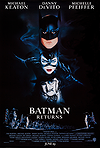 Posted : 5 years ago on 26 June 2020 02:09
(A review of Batman Returns)
Posted : 5 years ago on 26 June 2020 02:09
(A review of Batman Returns)Paving the way for Christopher Nolan's fully-realised noir conceit of crime-riddled Gotham, Tim Burton's "Batman Returns" trounces every preceding version of the Caped Crusader's expansive sandbox. Gotham, as realised by Burton, is stylistically and visually reminiscent of German Expressionist cinema, albeit with flashes of kitsch and camp incorporated into the costumes and props, the sets swathed in snow, smog and shadows, all of which may seem incongruous, but once you are presented with it in action, it all coheres and works magnificently. With the arrival of his most well-drawn, complex adversaries, Penguin and Catwoman, the story takes place some time after the events of the first film with Batman assimilated into Gotham City as its resident masked vigilante.
Pursuing one such foe, Catwoman, sees Batman meet his match, and naturally, they develop a tenuous symbiosis in disguise and out. Catwoman, driven by a personal vendetta against ruthless businessman Max Shreck, slants Batman's moral compass, exposing his difficulty in separating an uncompromising obligation to Gotham and his underlying loneliness as Bruce Wayne. Crucial to this romantic dilemma is Catwoman's flirtatious sparring with Batman and her alter ego Selina Kyle's charged exchanges with Bruce Wayne. It is this sexual undertone and the over-arching theme of duality within the superhero mythos that elevates the film beyond mere comic book adaptation fare without substance. Anyone aware of the finer subtext of DC's greatest detective should recognise Batman as the dominant persona and Bruce Wayne the subterfuge - they are indivisible. This is a theory carried over to the rogues gallery's least represented villain, Penguin - abandoned at birth by his upper-class parents due to his physical deformity, a parallel of sorts that links him to all the first-born sons of Gotham, including Bruce Wayne. Tim Burton's affinity for misfits imbues his film with a discernible poignancy, thus elucidating and going some way to explain the motivations of Penguin, who is, despite his bizarre exterior and Machiavellian nature, a misunderstood victim of circumstance. On screen in the 1960s, the DC Rogues Gallery consisted of The Joker and then less formidable, easily overcome criminal outcasts he collaborated with written as two-dimensional opponents of Batman merely to fortify his strength and power as a morally upright hero. Penguin and Catwoman are as substantial and integral to the plot as Batman; these richly nuanced studies of the two expand and liberate the characters from their comic book trappings, peeling at the layers of their shattered psyches. It is simply a joy to behold Penguin and Catwoman as three-dimensional characters with hidden agendas marred by Batman's presence. Everything within that framework, the immensely evocative visuals, action-packed set pieces and astonishing performances, are of particular importance in establishing the filmmaker's strategy, which is primarily to satisfy the audience, but also provide comic book nerds with a low-key, understated Batman, far removed from any other in the lexicon in the sense that he is both wisecracking and stoic: an amalgam of the seriousness of the 1980s comics as well as the florid panache of the classic Adam West epitomisation. Batman's dependency on technology is more pronounced also, proving advantageous for his foil, who both form an uneasy alliance to destroy him by targeting these perceived strengths, only for Penguin's depraved nature to hilariously bring about its swift end. It is these additional strokes of genius with character development that allow the film to bypass all others in the canon. For example, this advance by Penguin also showcases Catwoman's newfound sexual magnetism in her slinky black suit, contrasting with her lack of success with men as Selina Kyle. It is extremely masterful screenwriting in motion, and it holds up remarkably well even after other writers have since caught onto the potential of fleshing out the back story of the more interesting villains the hero pursues.
"Batman Returns" was not as widely popular with audiences and critics as its predecessor owing to its strangeness, converging plotlines, stronger violence and sexual references. Suffused with humour in a black vein, the film's deeply rewarding screenplay courtesy of "Heathers" scribe Daniel Waters, is the vital component as well as its detriment; the reason it failed to connect with audiences on a universal scale is that such a packed narrative demands dissection as if it were a cult film - the attention to detail, in-jokes, and indelible lines recited. It is designed to be pored over as a standalone film or loose continuation of the 1989 origin story, not to be taken seriously as part of the wider mythology of Batman, it is so versatile in terms of tonality, it could fit into any category, even the Christmas movie. Demonstrating the tragicomic qualities of Bruce Wayne and his enemies more than any other incarnation, "Batman Returns" is an atmospheric microcosm of Burton's tortured Gothic sensibility and prevaling recondite zaniness that through commendable character work, indelible dialogue, astonishing set design, and a hauntingly romantic disposition rarely afforded to commercial cinema, is tempered and moulded into a great film loaded with much to explore if it elicits the same response in you as it does me.
Pursuing one such foe, Catwoman, sees Batman meet his match, and naturally, they develop a tenuous symbiosis in disguise and out. Catwoman, driven by a personal vendetta against ruthless businessman Max Shreck, slants Batman's moral compass, exposing his difficulty in separating an uncompromising obligation to Gotham and his underlying loneliness as Bruce Wayne. Crucial to this romantic dilemma is Catwoman's flirtatious sparring with Batman and her alter ego Selina Kyle's charged exchanges with Bruce Wayne. It is this sexual undertone and the over-arching theme of duality within the superhero mythos that elevates the film beyond mere comic book adaptation fare without substance. Anyone aware of the finer subtext of DC's greatest detective should recognise Batman as the dominant persona and Bruce Wayne the subterfuge - they are indivisible. This is a theory carried over to the rogues gallery's least represented villain, Penguin - abandoned at birth by his upper-class parents due to his physical deformity, a parallel of sorts that links him to all the first-born sons of Gotham, including Bruce Wayne. Tim Burton's affinity for misfits imbues his film with a discernible poignancy, thus elucidating and going some way to explain the motivations of Penguin, who is, despite his bizarre exterior and Machiavellian nature, a misunderstood victim of circumstance. On screen in the 1960s, the DC Rogues Gallery consisted of The Joker and then less formidable, easily overcome criminal outcasts he collaborated with written as two-dimensional opponents of Batman merely to fortify his strength and power as a morally upright hero. Penguin and Catwoman are as substantial and integral to the plot as Batman; these richly nuanced studies of the two expand and liberate the characters from their comic book trappings, peeling at the layers of their shattered psyches. It is simply a joy to behold Penguin and Catwoman as three-dimensional characters with hidden agendas marred by Batman's presence. Everything within that framework, the immensely evocative visuals, action-packed set pieces and astonishing performances, are of particular importance in establishing the filmmaker's strategy, which is primarily to satisfy the audience, but also provide comic book nerds with a low-key, understated Batman, far removed from any other in the lexicon in the sense that he is both wisecracking and stoic: an amalgam of the seriousness of the 1980s comics as well as the florid panache of the classic Adam West epitomisation. Batman's dependency on technology is more pronounced also, proving advantageous for his foil, who both form an uneasy alliance to destroy him by targeting these perceived strengths, only for Penguin's depraved nature to hilariously bring about its swift end. It is these additional strokes of genius with character development that allow the film to bypass all others in the canon. For example, this advance by Penguin also showcases Catwoman's newfound sexual magnetism in her slinky black suit, contrasting with her lack of success with men as Selina Kyle. It is extremely masterful screenwriting in motion, and it holds up remarkably well even after other writers have since caught onto the potential of fleshing out the back story of the more interesting villains the hero pursues.
"Batman Returns" was not as widely popular with audiences and critics as its predecessor owing to its strangeness, converging plotlines, stronger violence and sexual references. Suffused with humour in a black vein, the film's deeply rewarding screenplay courtesy of "Heathers" scribe Daniel Waters, is the vital component as well as its detriment; the reason it failed to connect with audiences on a universal scale is that such a packed narrative demands dissection as if it were a cult film - the attention to detail, in-jokes, and indelible lines recited. It is designed to be pored over as a standalone film or loose continuation of the 1989 origin story, not to be taken seriously as part of the wider mythology of Batman, it is so versatile in terms of tonality, it could fit into any category, even the Christmas movie. Demonstrating the tragicomic qualities of Bruce Wayne and his enemies more than any other incarnation, "Batman Returns" is an atmospheric microcosm of Burton's tortured Gothic sensibility and prevaling recondite zaniness that through commendable character work, indelible dialogue, astonishing set design, and a hauntingly romantic disposition rarely afforded to commercial cinema, is tempered and moulded into a great film loaded with much to explore if it elicits the same response in you as it does me.
 0 comments, Reply to this entry
0 comments, Reply to this entry
Butch Cassidy and the Sundance Kid review
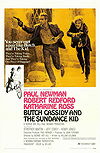 Posted : 5 years ago on 25 June 2020 02:33
(A review of Butch Cassidy and the Sundance Kid)
Posted : 5 years ago on 25 June 2020 02:33
(A review of Butch Cassidy and the Sundance Kid)Disarmingly charming to the hilt, George Roy Hill's revisionist take on the western centres on two friends, one skilled, the other smart, operating as leaders of the Hole-in-the-Wall gang. With their tradition now falling out of fashion with the public at the turn of the Century, the bandits are confronted with changing times that they must adapt to in order to survive. Upon returning to Wyoming after their latest sojourn, the affable companions find themselves faced with the prospect of the advancing Old West, as well as their leadership and fearsome reputation, phasing out. Opting to become highwaymen and rob trains rather than banks, Butch and the Kid are subsequently relentlessly tracked by a hired superposse. After losing their trail, Butch suggests making their escape to "robber's paradise" Bolivia in a bid to elude their pursuers, to which the Kid reluctantly agrees. Owing to the squalid living conditions of Bolivia, the duo turn to bank robbing again, and with the Kid's schoolmarm lover as an accomplice, become even more successful and famous, perhaps dangerously so; their fugitive status is soon revealed to the wider public outside of South America and they are forced to go straight, working as payroll guards until it all goes disastrously wrong. It is the farcical elements and fast pacing of the story that prove to be the most entertaining and enjoyable facets, lending the film a jaunty tone and light-heartedness that often spills over into comedy. Even during action-packed sequences and the climactic gunfight, the titular pair's chaffing exchanges are deliriously funny, all thanks to Paul Newman and Robert Redford's chemistry. Utilizing stylistic deviations and a wonderfully chirpy musical score courtesy of Burt Bacharach to enhance the film's pathos-laden upbeat mood, George Roy Hill expertly crafts a breezy buddy movie that hinges on its more civilised Old West setting as a plot device to doom his main characters from the sepia-toned opening credits. "Butch Cassidy and the Sundance Kid" is a joy to watch no matter what category it fits into, it is a sublime piece of progressive American cinema that is definitely of its time, in a good way.
 0 comments, Reply to this entry
0 comments, Reply to this entry
The Good, the Bad and the Ugly review
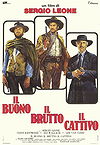 Posted : 5 years ago on 25 June 2020 07:46
(A review of The Good, the Bad and the Ugly)
Posted : 5 years ago on 25 June 2020 07:46
(A review of The Good, the Bad and the Ugly)Taking an entirely sardonic attitude in its depiction of the west, "The Good, the Bad and the Ugly" is the final instalment in Sergio Leone's unofficial Dollars trilogy. "A Fistful of Dollars" and "For A Few Dollars More" were unequivocally episodic and exponentially expelled to classic status by Clint Eastwood's laconic, enigmatic Man With No Name. Central to the series and its distinctive visual language were the landscapes of New Mexico, explicitly showcased rough, bloody violence and highly ambiguous morals and mercenary motives of the characters. "The Good, the Bad and the Ugly" deviated from the blueprint set by Leone in delivering more adeptly composed cinematography and a cohesive, substantial narrative worthy of its near-three-hour runtime whilst retaining and extending the showdown aspect of its predecessors. Conversely suffused with poignancy and jocularity, the trilogy's fetishistic emphasis on excessive beatings and sudden gunfights, illustrative realism, authentic minutiae and dishevelled, unprincipled, cigar-smoking killers reaches its apex here, with the core plotline acting as a deconstruction of Old West romanticism, favouring the complexities and double-crossing antics between sympathetic criminal antiheroes and callous, irredeemable villains over plain old good versus evil. Leone magnifies and expands upon every element of his previous films, becoming more grandiose with his own iconography: a mythical figure raised by the American spirit now enters even more perilous territory, attacking the Puritanism of its heartland by interspersing long shots of dustlands, graveyards and war-torn scenery. It is this visual signature that notably progresses the film's character development, the continuous extreme close-up; demonstrated by a stony stare, reactionary expression or itchy-fingered hand hovering beside a gun, are one of many recurring keynotes throughout, thus defining the characters by their deeply nefarious actions, variegated by levels of relentlessness, not their humour-laden functional dialogue.
Narrating the search for gold through the classification of violence, uneasy alliance of a trio of reprobates and dispensing with the faster pacing of other Spaghetti Westerns, Leone opts to use scope and time, protracting the spell between reactions and the sudden shootout, employed perhaps to build suspense and also underscore his film with cinematographic techniques, stylistic touches and motifs now synonymous with the genre. Kill or be killed, backstab or be backstabbed designate the mentality of the males inhabiting Leone's arid west; devoid of exoticism, hope or beauty, it is a troublesome, decaying world beset by ruthlessness, murder and brutality. The only opportunity for any of the characters is to kill for profit, so the prospect of gold is a welcome change from this monotonous existence. Leone's propensity for re-invention sees him place the pursuit of monetary acquisition by any means necessary amongst the historical context of the American Civil War, entwining the characters in the battle as they travel to the uncertain location of the stolen Confederate gold. Operatic and intense, there is also a boyishness to the adventure aspect of the narrative that dulls the action, infusing a melancholy into the proceedings on several occasions, thus fortifying the plot and ensuring that the audience remains engrossed until the climactic standoff. What is most integral to the film's sustained dramatic tension is its musical theme by Ennio Morricone, which succeeds in accentuating pivotal moments, such as the breathtaking Mexican standoff at the cemetery. As with other facets of Leone's direction, the music breaks with convention; coordination with scenes, as well as adding vocals and alluding to other compositions within and outside of the trilogy, are all factors in its complimenting of the setting and camera movements. All of these fundamentals combine to distinguish it as a classic, moreover, its rewatchable qualities. It is a near-perfect masterpiece, and there are not many western satires that can be certain of that merit.
Narrating the search for gold through the classification of violence, uneasy alliance of a trio of reprobates and dispensing with the faster pacing of other Spaghetti Westerns, Leone opts to use scope and time, protracting the spell between reactions and the sudden shootout, employed perhaps to build suspense and also underscore his film with cinematographic techniques, stylistic touches and motifs now synonymous with the genre. Kill or be killed, backstab or be backstabbed designate the mentality of the males inhabiting Leone's arid west; devoid of exoticism, hope or beauty, it is a troublesome, decaying world beset by ruthlessness, murder and brutality. The only opportunity for any of the characters is to kill for profit, so the prospect of gold is a welcome change from this monotonous existence. Leone's propensity for re-invention sees him place the pursuit of monetary acquisition by any means necessary amongst the historical context of the American Civil War, entwining the characters in the battle as they travel to the uncertain location of the stolen Confederate gold. Operatic and intense, there is also a boyishness to the adventure aspect of the narrative that dulls the action, infusing a melancholy into the proceedings on several occasions, thus fortifying the plot and ensuring that the audience remains engrossed until the climactic standoff. What is most integral to the film's sustained dramatic tension is its musical theme by Ennio Morricone, which succeeds in accentuating pivotal moments, such as the breathtaking Mexican standoff at the cemetery. As with other facets of Leone's direction, the music breaks with convention; coordination with scenes, as well as adding vocals and alluding to other compositions within and outside of the trilogy, are all factors in its complimenting of the setting and camera movements. All of these fundamentals combine to distinguish it as a classic, moreover, its rewatchable qualities. It is a near-perfect masterpiece, and there are not many western satires that can be certain of that merit.
 0 comments, Reply to this entry
0 comments, Reply to this entry
Movies
Top rated |
 My movies page My movies page Rated 2142 movies Rated 2142 movies |
TV
Top rated |
 My tv page My tv page Rated 18 tv Rated 18 tv |
Music
Top rated |
 My music page My music page Rated 12 music Rated 12 music |
DVDs
Top rated |
 My dvds page My dvds page Rated 3 dvds Rated 3 dvds |
My feed
flyflyfly added A Good Girl's Guide to Murder to have watched list
11 months, 1 week ago
flyflyfly added 5 items to their collection
11 months, 2 weeks ago
flyflyfly added The Haunting of Bly Manor to have watched list
11 months, 3 weeks ago
flyflyfly added The Fall of the House of Usher to have watched list
11 months, 4 weeks ago
flyflyfly added Little Richard: I Am Everything to have watched list
11 months, 4 weeks ago
flyflyfly added 5 items to their collection
1 year ago
flyflyfly added 5 items to their collection
1 year ago
flyflyfly added Thank You, Goodnight: The Bon Jovi Story to have watched list
1 year, 1 month ago
flyflyfly added Jane Fonda in Five Acts to have watched list
1 year, 1 month ago
 Login
Login
 Message
Message
 Home
Home 4 Lists
4 Lists 55 Reviews
55 Reviews Collections
Collections






















































If you are interested and you want to check the end-result, you can use the following link :
Listal's 100 Films To See Before You Die (2022)
The list has been updated with your vote.
If you want, you can double-check the end-result : www.listal.com/list/listals-100-films-see-before-8601
If you are interested and you want to check the end-result, you can use the following link :
Listal's 100 Films To See Before You Die (2020)
If you want, you can double-check the end-result : www.listal.com/list/listals-100-films-see-before-9545
I'm currently working on a new project and maybe you could help me out.
It's pretty simple.
You just need to click on the link underneath and provide your 10 favorite movies.
www.listal.com/list/listals-100-films-see-before-9545
Thanks in advance! :)